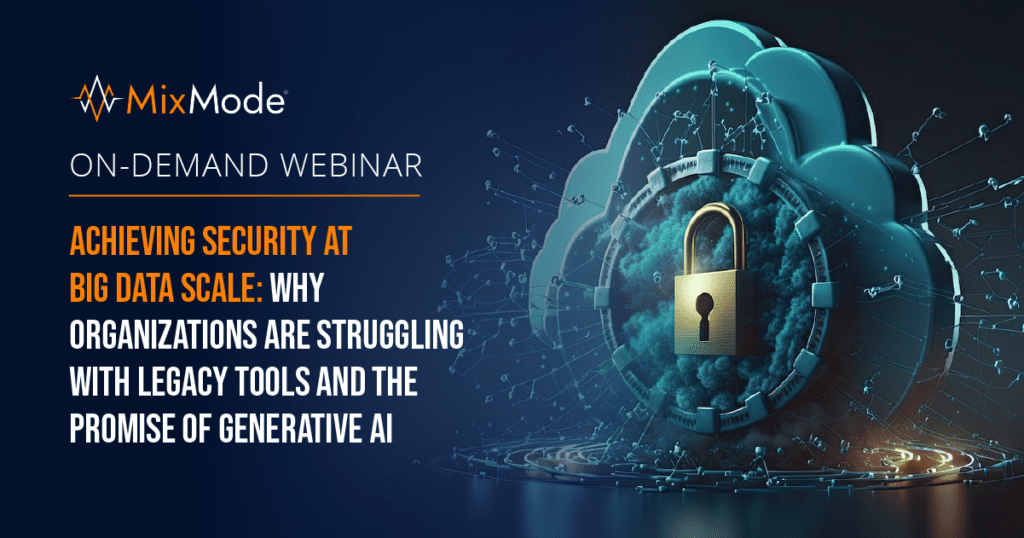In a recent cybersecurity expert panel webinar, industry veterans gathered to discuss the challenges large enterprises in the Fortune 1000 face in scaling security monitoring and threat detection across big data environments. As the volume of data generated by organizations continues to grow exponentially, legacy security tools are struggling to keep up. The panelists, representing various security and technology roles, dive into the complexities of modern cybersecurity and propose potential solutions to address these challenges.
Expert Panel:

The Challenge of Scale in Big Data Security

The discussion begins by acknowledging the vast amount of data generated daily by organizations, especially those operating in cloud and hybrid environments. The scalability limitations of legacy security tools are highlighted, as these tools tend to falter when dealing with an influx of data. When data generation surpasses a certain threshold, the accuracy of legacy security tools decreases, leading to blind spots and potential security vulnerabilities.
For instance, in a cloud environment, a Fortune 1000 company generates approximately 11 billion events and records daily, revealing the staggering scale of data being processed. However, most legacy tools struggle to handle this level of data, resulting in organizations ignoring around 99% of the events generated.
Key Challenges Facing Security Teams
The panelists discuss several significant challenges that organizations are currently grappling with:
- Scalability and Integration: Organizations struggle to find solutions that can scale effectively across multiple environments (on-premises, cloud, and hybrid). Integrating different solutions to achieve consistent visibility across these diverse environments proves to be complex.
- Complex Cloud Environments: The dynamic and constantly evolving nature of cloud environments, coupled with various cloud providers, makes it challenging to maintain effective security measures across different cloud platforms.
- Latency and Speed: As organizations incorporate zero-trust principles and aim to gather telemetry for users, applications, and data, the challenge lies in achieving real-time speed while dealing with latency in network and data processing.
- Data Sovereignty and Privacy: The globalization of organizations brings data sovereignty and privacy concerns to the forefront, necessitating automation of data architecture to ensure compliance with regulations like GDPR.
- Emerging Threat Landscape: The ever-changing threat landscape requires security teams to stay ahead of new and evolving threats across complex and dynamic environments.
Limitations of Legacy Approaches
The panelists emphasize the limitations of existing legacy approaches to cybersecurity, which include:
- Tool Proliferation: Organizations often end up with numerous security tools and dashboards, leading to complexity and inefficiency in managing security incidents.
- Hybrid Complexity: Hybrid environments require security teams to manage both on-premises and cloud-based systems, resulting in challenges related to expertise and configuration management.
- Automation Shortcomings: Legacy tools struggle with automation, especially in rapidly changing cloud environments. Manual intervention is required to adapt tools to new services and data sources.
- Talent Pool and Expertise: The convergence of security and operational responsibilities in cloud platforms creates challenges in finding individuals with the right skill sets to manage complex security requirements.
- False Positives: Existing tools generate numerous false positives due to their inability to adapt to changing data and event patterns, overwhelming security teams.
The Role of Generative AI in Solving Big Data Security Challenges
The panelists do express optimism about the potential of Generative AI to address these challenges. They highlighted the following ways in which AI can help enhance cybersecurity:
- Automated Response: AI can rapidly detect, analyze, and respond to security incidents, reducing the time required for human intervention and increasing the efficiency of security operations.
- Dynamic Adaptation: AI can adapt to changes in data sources, event patterns, and new cloud services, maintaining effectiveness even in highly dynamic environments.
- False Positive Reduction: AI can significantly reduce the number of false positives generated by security tools, enabling security teams to focus on genuine threats.
- Operational Efficiency: By automating repetitive tasks and augmenting the capabilities of security analysts, AI can improve operational efficiency and reduce the overall resource burden.
Looking Towards the Future
As organizations continue to grapple with the challenges of securing big data at scale, the consensus among the panelists is that AI holds great promise in transforming cybersecurity. By harnessing AI’s ability to process and analyze vast amounts of data in real time, organizations can enhance their security posture, reduce response times, and improve overall operational efficiency.
While AI is not a silver bullet, it represents a critical tool in the evolving landscape of cybersecurity, enabling organizations to keep pace with the exponential growth of data and the increasingly sophisticated tactics of cyber threats.
Check out the full webinar on-demand here for a more detailed discussion and even more insights on how next-generation platforms can offer a solution to big data problems by enabling real-time threat detection at scale.
Other MixMode Articles You Might Like
MixMode Strengthens Generative AI Threat Detection Platform with New Enhancements
Zero Day Summer is No Vacation
FBI Warns of Adversary Malicious AI Use While Encouraging AI Cyber Adoption
MixMode Highlighted in Gartner® Hype Cycle™ for Security Operations 2023
Combating Alert Fatigue with the MixMode AI Assistant
Securing Your Cloud Environment: Understanding and Addressing the Challenges in Cloud Security


